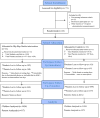Improving Community Stroke Preparedness in the HHS (Hip-Hop Stroke) Randomized Clinical Trial
- PMID: 29567762
- PMCID: PMC5871596
- DOI: 10.1161/STROKEAHA.117.019861
Improving Community Stroke Preparedness in the HHS (Hip-Hop Stroke) Randomized Clinical Trial
Abstract
Background and purpose: Deficiencies in stroke preparedness cause major delays to stroke thrombolysis, particularly among economically disadvantaged minorities. We evaluated the effectiveness of a stroke preparedness intervention delivered to preadolescent urban public school children on the stroke knowledge/preparedness of their parents.
Methods: We recruited 3070 fourth through sixth graders and 1144 parents from 22 schools into a cluster randomized trial with schools randomized to the HHS (Hip-Hop Stroke) intervention or attentional control (nutrition classes). HHS is a 3-hour culturally tailored, theory-based, multimedia stroke literacy intervention targeting school children, which systematically empowers children to share stroke information with parents. Our main outcome measures were stroke knowledge/preparedness of children and parents using validated surrogates.
Results: Among children, it was estimated that 1% (95% confidence interval [CI], 0%-1%) of controls and 2% (95% CI, 1%-4%; P=0.09) of the intervention group demonstrated optimal stroke preparedness (perfect scores on the knowledge/preparedness test) at baseline, increasing to 57% (95% CI, 44%-69%) immediately after the program in the intervention group compared with 1% (95% CI, 0%-1%; P<0.001) among controls. At 3-month follow-up, 24% (95% CI, 15%-33%) of the intervention group retained optimal preparedness, compared with 2% (95% CI, 0%-3%; P<0.001) of controls. Only 3% (95% CI, 2%-4%) of parents in the intervention group could identify all 4 letters of the stroke FAST (Facial droop, Arm weakness, Speech disturbance, Time to call 911) acronym at baseline, increasing to 20% at immediate post-test (95% CI, 16%-24%) and 17% at 3-month delayed post-test (95% CI, 13%-21%; P=0.0062), with no significant changes (3% identification) among controls. Four children, all in the intervention group, called 911 for real-life stroke symptoms, in 1 case overruling a parent's wait-and-see approach.
Conclusions: HHS is an effective, intergenerational model for increasing stroke preparedness among economically disadvantaged minorities.
Clinical trial registration: URL: https://clinicaltrials.gov. Unique identifier: NCT01497886.
Keywords: child; multimedia; parents; school; speech.
© 2018 American Heart Association, Inc.
Conflict of interest statement
References
-
- Tong D, Reeves MJ, Hernandez AF, et al. Times from symptom onset to hospital arrival in the Get with the Guidelines--Stroke Program 2002 to 2009: temporal trends and implications. Stroke. 2012;43:1912–1917. - PubMed
-
- Schwamm LH, Ali SF, Reeves MJ, et al. Temporal trends in patient characteristics and treatment with intravenous thrombolysis among acute ischemic stroke patients at Get With The Guidelines-Stroke hospitals. Circulation Cardiovascular quality and outcomes. 2013;6:543–549. - PubMed
-
- Schwamm LH, Reeves MJ, Pan W, et al. Race/ethnicity, quality of care, and outcomes in ischemic stroke. Circulation. 2010;121:1492–1501. - PubMed
-
- Investigators CASPR. Prioritizing interventions to improve rates of thrombolysis for ischemic stroke. Neurology. 2005;64:654–659. - PubMed
-
- Robinson TG, Reid A, Haunton VJ, Wilson A, Naylor AR. The face arm speech test: does it encourage rapid recognition of important stroke warning symptoms? Emergency medicine journal : EMJ. 2013;30:467–471. - PubMed
Publication types
MeSH terms
Associated data
Grants and funding
LinkOut - more resources
Full Text Sources
Other Literature Sources
Medical
Miscellaneous



